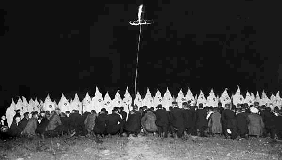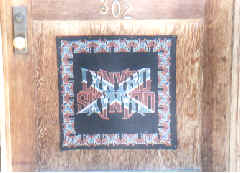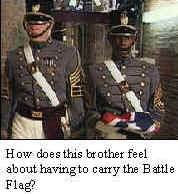 By: Michael T. McPhearson
By: Michael T. McPhearson
April / May / June 2001
I have heard people say, “I never talk God, sex, or politics in mixed company.” Symbols should be added to that list. So much emotion is wrapped up in symbols. And, in this country few symbols stir passions more than the Confederate Battle Flag and the Flag of the United States of America.
Recently the citizens of the state of Mississippi voted 494,323 to 273,359 to keep the Confederate battle flag as part of their state flag. While hurtful to me as an African-American, it was far from surprising. Last year the Confederate battle flag issue dominated South Carolina politics and headlines. The flag had officially flown over the capitol building since 1962 when raised in celebration of the 100th anniversary of the Civil War. State legislators, under pressure from an anti-Confederate flag coalition forged by the NAACP, decided to lower the flag. The Senate voted 36-7 while the House voted 63-56. But this victory came with a caveat; both legislative bodies proposed compromise locations for the flag. The Senate voted for a smaller Confederate Flag on a 20-foot pole at the Confederate soldiers’ monument in the front of the Statehouse. The House voted for a 30-foot pole surrounded by a decorative iron fence and illumination of the flag at night.
 Many opponents of the flag want it to go away altogether. Most people just wish the issue would go away. Neither is about to happen. South Carolina and Mississippi are only the latest campaigns in the flags wars. The Alabama, Florida, and Georgia State flags have elements of the Confederate Battle Flag in their designs. Any of these states could be the next target of anti-flag groups.
Many opponents of the flag want it to go away altogether. Most people just wish the issue would go away. Neither is about to happen. South Carolina and Mississippi are only the latest campaigns in the flags wars. The Alabama, Florida, and Georgia State flags have elements of the Confederate Battle Flag in their designs. Any of these states could be the next target of anti-flag groups.
The removal of the flag from the dome of the South Carolina Legislative building is due in part to the success of the anti-flag coalition as well as a swell of inclusive community building efforts taking place across the country. The standard language of diversity, tolerance, and acceptance describes the character of the movement. Unfortunately, the South Carolina legislators’ wish to continue to fly the flag and the majority of Mississippi’s voters’ disregard for fellow citizens’ feelings of alienation characterize the traditional and consistent mood of the nation when it comes to talking about American slavery. Let bygones be bygones. Let’s not talk about the past, look towards the future. South Carolina’s actions gave me hope that the states that still have Confederate emblems on their flags could have new designs by 2010. But the recent Mississippi vote dashed that expectation.  One thing is for certain. If there is a turn in events and Alabama, Florida, Mississippi, and Georgia decided that a state flag should represent the freedom, hopes and expectations all of its citizens, and not fly as a reminder of documented state sponsored oppression, and remove the Confederate symbol from their state flags, it would not end the controversy. The Confederate Battle Flag is embedded in United States history and its image is here to stay.
One thing is for certain. If there is a turn in events and Alabama, Florida, Mississippi, and Georgia decided that a state flag should represent the freedom, hopes and expectations all of its citizens, and not fly as a reminder of documented state sponsored oppression, and remove the Confederate symbol from their state flags, it would not end the controversy. The Confederate Battle Flag is embedded in United States history and its image is here to stay.
 While taking a walk last year on Memorial Day I discovered I live near an Annin factory, a company that makes United States’ flags. A sign reading “Annin, Flag Makers to the World Sine 1847” sent me through a stream of conflicting emotions. I laughed and wondered when did the first Confederate Battle Flag fly? I thought about all the smiling, flesh-pressing members of the United States Senate that fell only 4 votes short of passing an amendment to the constitution to make it a criminal offense to desecrate the United States Flag. I thought about the blood irrigated hot southern fields, the sinews chained to help take a country, and the lives damned to bondage. How dare they try to legislate respect? The arrogance of it alone is an act of tyranny. Then I looked around and saw that it was a beautiful Memorial Day 2000 in the neighborhood, and Old Glory replicas of all shapes and sizes flew proud and true. It made me feel good to be surrounded by the Stars and Stripes. If I were home, there would surely be a few Confederate flags mixed in too.
While taking a walk last year on Memorial Day I discovered I live near an Annin factory, a company that makes United States’ flags. A sign reading “Annin, Flag Makers to the World Sine 1847” sent me through a stream of conflicting emotions. I laughed and wondered when did the first Confederate Battle Flag fly? I thought about all the smiling, flesh-pressing members of the United States Senate that fell only 4 votes short of passing an amendment to the constitution to make it a criminal offense to desecrate the United States Flag. I thought about the blood irrigated hot southern fields, the sinews chained to help take a country, and the lives damned to bondage. How dare they try to legislate respect? The arrogance of it alone is an act of tyranny. Then I looked around and saw that it was a beautiful Memorial Day 2000 in the neighborhood, and Old Glory replicas of all shapes and sizes flew proud and true. It made me feel good to be surrounded by the Stars and Stripes. If I were home, there would surely be a few Confederate flags mixed in too.
One History
 I have a familiar relationship with both the Confederate Battle Flag and the Flag of the United States. They have been highly visible symbols in my life from birth. The Confederate Battle Flag reminds me of home, the U.S. South. It reminds me of the history of hate in the South. Hate is the reason the battle flag was originally brought to my attention. When you are a person of non-white skin and live in close proximity to racist and bigots, you must pay close attention to such things like the rebel flag. It is the perpetual banner of the Klu Klux Klan, an organization born in hate. It was the flag flown into battle by the Confederate States of America, a nation formed to defend the State’s right to preserve the institution of slavery. It is hard for me to think of the battle flag and not think of hate. But that is not all I think about. In fact it is not always the first thing that comes to mind. It kind of depends on where I see it. If I see it on the cover of a book, I usually guess it’s text is about the Civil War or the South in general. When I was younger and I saw it on a belt buckle, cap, mud flaps, license plate, or T-shirt I would think Redneck. Today I think of America trying to ignore its history of slavery and deny the legacy of racism that is alive in our minds today.
I have a familiar relationship with both the Confederate Battle Flag and the Flag of the United States. They have been highly visible symbols in my life from birth. The Confederate Battle Flag reminds me of home, the U.S. South. It reminds me of the history of hate in the South. Hate is the reason the battle flag was originally brought to my attention. When you are a person of non-white skin and live in close proximity to racist and bigots, you must pay close attention to such things like the rebel flag. It is the perpetual banner of the Klu Klux Klan, an organization born in hate. It was the flag flown into battle by the Confederate States of America, a nation formed to defend the State’s right to preserve the institution of slavery. It is hard for me to think of the battle flag and not think of hate. But that is not all I think about. In fact it is not always the first thing that comes to mind. It kind of depends on where I see it. If I see it on the cover of a book, I usually guess it’s text is about the Civil War or the South in general. When I was younger and I saw it on a belt buckle, cap, mud flaps, license plate, or T-shirt I would think Redneck. Today I think of America trying to ignore its history of slavery and deny the legacy of racism that is alive in our minds today.
When I go to a flag store or souvenir shop in a state outside the South and I see the Confederate battle flag, I think of my home state of North Carolina. I think of my southern heritage. A lot of wonderful things have come out of the South. I call the region the Soul of the nation. Being friendly and neighborly is not called Northern or Mid Western hospitality. Southern food, well let’s just say there’s nothing better. The best pork or BBQ, the best collard greens, the best mustard greens, the best yams, the best catfish, the best peach cobbler, the best cornbread, the best baked ham, the best ice tea, and the coldest lemonade is in the South. Can’t forget fried chicken. And the grits, I have actually gone to some parts of the country and they did not have grits on the menu for breakfast. And they think Southerners are ignorant?
 The hymns sung along the Mississippi Delta spawned American popular music from the Blues and Jazz to Rock and Roll, R & B, Hip Hop, and anything in between. The Civil Rights Movement did not begin in the North or the West. It sprung from the pain and suffering of Southern people. The South led the nation in a wave of protest igniting the Student Movement, the Second Wave of the Women’s Movement, the Peace Movement, and the Lesbian and Gay Rights Movement. We have yet to see the full impact of the Civil Rights Movement on world history. Although it has done little to change the condition of the poor, it has raised our expectation of civil liberties and the level of interpersonal respect we have for each other. The U.S. South saw the birth of a paradigm that will help lead the emerging global society towards inclusive community building in the new century. The Civil Rights Movement in the United States raised the human rights bar for the world.
The hymns sung along the Mississippi Delta spawned American popular music from the Blues and Jazz to Rock and Roll, R & B, Hip Hop, and anything in between. The Civil Rights Movement did not begin in the North or the West. It sprung from the pain and suffering of Southern people. The South led the nation in a wave of protest igniting the Student Movement, the Second Wave of the Women’s Movement, the Peace Movement, and the Lesbian and Gay Rights Movement. We have yet to see the full impact of the Civil Rights Movement on world history. Although it has done little to change the condition of the poor, it has raised our expectation of civil liberties and the level of interpersonal respect we have for each other. The U.S. South saw the birth of a paradigm that will help lead the emerging global society towards inclusive community building in the new century. The Civil Rights Movement in the United States raised the human rights bar for the world.
Yet with all of these positive visions, before I can dismiss the thought of the Confederate Battle Flag, the hate bleeds through.
I pondered a bit during the last few years about this comfortable, uncomfortable relationship I have developed with the Confederate battle flag. I could not intellectually reconcile my emotional acceptance of the symbol. How could I see so much of myself in a flag that has come to personify the oppression of my family, my ancestors, and myself?
Then it hit me. I have a similar but more deeply felt anxiety about a symbol I hold most dear, the Flag of the United States of America.
The roots of the Stars and Stripes run deep in the African Diasporaic experience. Long before the first Confederate Battle Flag was stitched black slaves landed in New Amsterdam, then a Dutch settlement on the tip of what is now Manhattan in 1626. When Mrs. Ross sewed the first U.S. flag in 1776 the English slave trade was over a century old. From 1776 to the end of slavery in North America, the flag, originally designed by George Washington, flew proudly for eighty-nine years as a sponsor of slavery. The U.S. ended the Confederates’ brief four year history as a slave nation with the Emancipation Proclamation in 1864. Slavery was finally made illegal in all of the United States and territories with the passage of the 13th Amendment in 1865, only to have an American Apartheid legal system take its place. A segregated culture prevailed until 1954 when the United States’ Supreme Court ruled in the Brown v. Topeka Board of Education that ‘separate but equal’ was a contradiction in terms, and unequal treatment under the 14th Amendment. Of course, the struggle for equality for all citizens under the law did not end with that, but it gave momentum to the Civil Rights Movement and those movements that followed.
 Times have changed, but a lot remains the same. Both European Americans and African Americans have called me a nigger. I have been followed in stores. I have been told, “you don’t sound Black.” I have been asked on several occasions while shopping in K-Mart, Wal-Mart, or some other store if I worked there, when I did not have a red vest on, or a smiley face, name tag or anything else that would identify me as working in the store. I guess I just have that sales associate kind of look. I have been asked to leave a bar, because “we don’t like your kind hanging around here.” I have been ignored and then watched as a person with white skin was promptly helped. I have watched people cross the street to avoid walking near me. I have been told “no vacancy” in an apartment complex when I knew one existed. People I had never met, full of condescension, have called me “boy”. Fortunately my brown skin has not brought me physical harm. But the constant stories seen and heard of African-American men being stopped and killed by the police, or attacked by white supremacists, causes me to pray to be kept safe from criminals and those sworn to protect me. Since I have dealt with living in America as a “Black” person all my life I have gotten used to it.
Times have changed, but a lot remains the same. Both European Americans and African Americans have called me a nigger. I have been followed in stores. I have been told, “you don’t sound Black.” I have been asked on several occasions while shopping in K-Mart, Wal-Mart, or some other store if I worked there, when I did not have a red vest on, or a smiley face, name tag or anything else that would identify me as working in the store. I guess I just have that sales associate kind of look. I have been asked to leave a bar, because “we don’t like your kind hanging around here.” I have been ignored and then watched as a person with white skin was promptly helped. I have watched people cross the street to avoid walking near me. I have been told “no vacancy” in an apartment complex when I knew one existed. People I had never met, full of condescension, have called me “boy”. Fortunately my brown skin has not brought me physical harm. But the constant stories seen and heard of African-American men being stopped and killed by the police, or attacked by white supremacists, causes me to pray to be kept safe from criminals and those sworn to protect me. Since I have dealt with living in America as a “Black” person all my life I have gotten used to it.
Yet through the beating of Rodney King, the dragging death of James Byrd, the killings of Amadou Diallo and Patrick Dorismond, the murder of Matthew Shepard, the rapes, domestic violence and overall societal oppression of women, and the indifference to children, somehow freedom bleeds through. In my mother’s house we were taught God, family and country. We were taught to not to be ashamed of our slave heritage, but to feel the strength of our ancestors and see how that power lives on in us. Our mother taught us to respect human dignity and fight for freedom. As a consequence, I am an American patriot. I believe in our basic ideals of freedom: self-government, constitutional democracy, and inalienable rights. My actions as an American patriot are not centered on defense of borders and United States’ political interest. Creating a more perfect union that mirrors our stated ideals of life, liberty, and the pursuit of happiness for all people drives my patriotism. I expect to see our nation act in ways that support these principles and I resist actions that do not.
I have been told by some of my Brothers and Sisters that I have been brainwashed by the “White” man to believe in his system. They tell me I am stupid to believe in a country that has caused so much pain in the lives of dark skinned people. They chastise me for defending a system that today treats me, and so many others, as less than equal citizens. I share these feelings of anger and understand why many around the world and here at home see the United States flag as a symbol of oppression.
 The two flags vividly illustrate DuBois’ thesis: “One ever feels his two-ness, -an American, a Negro, two souls, two thoughts, two un-reconciled strivings; two warring ideas in one dark body, whose dogged strength alone keeps it from being torn asunder.” My anxiety is born of this dual relationship. The naked truth that the freedom of the United States was born on the backs of my ancestors, both First Nation People whose land was conquered and African slaves who made the land agriculturally productive. The story of the United States of America is one of great achievements and untellable horrors. It is a nation that has afforded tremendous blessing to some people and at the same time damned others to a life of unconscionable evil. The anxiety I feel is with the near truth of Pax Americana and all the good and bad that goes along with it. For when all is said and done, I am an American.
The two flags vividly illustrate DuBois’ thesis: “One ever feels his two-ness, -an American, a Negro, two souls, two thoughts, two un-reconciled strivings; two warring ideas in one dark body, whose dogged strength alone keeps it from being torn asunder.” My anxiety is born of this dual relationship. The naked truth that the freedom of the United States was born on the backs of my ancestors, both First Nation People whose land was conquered and African slaves who made the land agriculturally productive. The story of the United States of America is one of great achievements and untellable horrors. It is a nation that has afforded tremendous blessing to some people and at the same time damned others to a life of unconscionable evil. The anxiety I feel is with the near truth of Pax Americana and all the good and bad that goes along with it. For when all is said and done, I am an American.
So how do I reconcile the horror of genocide and slavery to be proud I am a citizen of the United States of America? Ask any immigrant, no matter what the color. With all our problems and dysfunctions, we live in a nation of opportunity and promise. The United States shines in the world as the beacon of freedom. It is my duty to honor my ancestors’ sacrifices by ensuring that the nation that was born in their blood and built on their bones continues to grow towards that more perfect union. I have no choice. I count myself as one of the brave.
FYI: A Confederate Battle Flag now flies on a 30-foot pole directly in front of the Capitol at the South Carolina Soldier Memorial.








